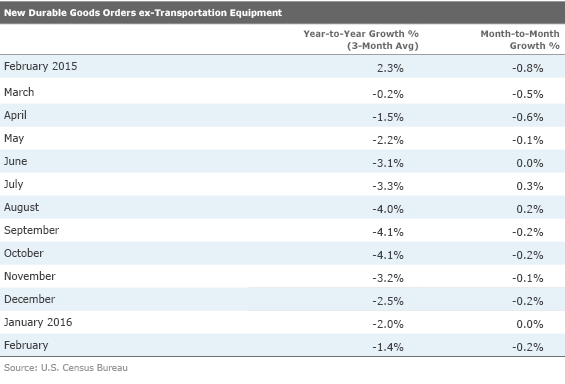Some markets will be open on Friday, so we will dispense with most of our weekly performance commentary. We will mention that the S&P 500 snapped its five-week winning streak (that produced a 10% gain) with a modest 0.7% loss. Two U.S. Federal Reserve governors, opining that a rate increase might not be far off, put a lid on this week's equity activity and propelled the dollar higher.
Economic news was sparse and inconclusive this week. Housing data showed decent monthly gains in new home sales and disappointing--but not unexpected--declines in existing-home sales. New paperwork requirements and unusual volatility make it difficult to read much into the housing data, although we didn't find anything too worrisome.
Durable goods, especially in core categories, were disappointing and showed outright declines on a monthly basis, even as year-over-year decline rates continue to contract. Markit flash purchasing manager reports in both Europe and the United States stopped going down in March after two months of declines. China will not report its data until the end of next week. We remain hopeful that we have seen the worst of the declines in manufacturing, but we aren't expecting a big snapback for the sector, either.
Housing data still trending up despite pesky volatility issues
Last week we opined that new home construction data would begin to look better on a month-to-month basis while existing homes are likely to face some weakness, not just in February, but potentially for the balance of 2016. That is exactly what we got as new home sales increased 2% and existing-home sales fell 7% on a month-to-month basis in February (from unusually high levels in both December and January). This is a trend that works in favour of higher economic growth, as new home construction benefits a lot more sectors of the economy than existing-home sales (which nevertheless boost broker commissions, furniture sales, and moving companies). New paperwork requirements that began in October have added a lot of volatility to both data sets. Discussion with my personal Realtor indicated that these new paperwork requirements are a bigger deal than expected and that she had lost a number of sales because of it. (Those sales might come back at a later date.) And some of the negative effects of the new rules are lingering five months after implementation.
Because of this odd volatility and some very strange seasonal patterns (January and February were the two best months for new home sales in 2015), we are going to dispense with our normal year-over-year data, which confuses a number of issues. The sequential unit sales data, averaged over three months, seems to better capture where we are in the housing market. Both new home and existing-home sales have shown steady improvement after the initial shock of the new paperwork requirements. However, the recent improvement has been somewhat larger in the new home market.

Nothing in this week's data changes our thinking on our full-year existing-home unit sales growth forecast of 3%-5%, or on our new home sales growth prediction of close to 10%, down from 6% and 15%, respectively, in 2015. However, when the remodeling market is added in, we believe that residential investment can still make about the same contribution to GDP in 2016 as it did in 2015, or about 0.3%.
Our relative optimism on the new home market is based largely on exceptionally low inventory levels for existing homes and near normal levels of inventory in the new home market, as shown below.

World PMI data: At least it didn't get any worse
Early in the week Markit released Flash PMI (purchasing manager) data for key developed markets that showed minuscule improvement after back-to-back declines for the first two months of the year. China, a key world player, no longer releases flash data. We tend to focus on the manufacturing sector, shown below.

These indexes, which lately seem more like a concurrent than leading indicator, appeared to stop going down in March after months of a generally downward trend. And at least the U.S. and Europe are seeing more companies reporting improvement than declines, as indicated by readings above 50.
Lately, the moves have been too small to signal much of anything, in our opinion. For all the warnings about slow world growth, falling prices and currency wars, the manufacturing sector isn't falling apart, by most indicators, but generally PMI readings for the services sector have been doing better than the manufacturing sector. For example, in the eurozone, the services category PMI jumped from 53.0 to 53.7, which represents an improvement and a better absolute level than the manufacturing numbers shown above.
Combining the two sectors for Europe suggests the European economy grew 0.3% or more in the first quarter (which if annualized, like the U.S. GDP data, produces a 1.2% annual growth rate). That would be similar to the fourth quarter. Reports out of Germany released early in the week suggested Germany might grow even faster.
It seems to us like a lot of European data is at least showing stabilization if not outright improvement, but even government releases are loaded with caveats that the worst is just around the corner. However, most of those warnings seemed to be based on poor sentiment surveys (which we take with a grain of salt, even in the U.S.) and continued low inflation or worries about poor growth elsewhere. While healthy skepticism is good, we hope the Europeans don't talk themselves into another slowdown. Our bet is that Europe will be a better relative performer in 2016 than most observers give it credit for.
U.S. durable goods orders slip in February, though year-over-year data struggles upward
Month-to-month headline durable goods orders looked terrible, falling 2.8% sequentially. Excluding the volatile transportation sector, orders were down 1.0% month to month, which was worse than expected. However, that followed an unsustainably high growth rate of 1.2% in January. Nevertheless, the February report was at least a little worrisome as six out of seven categories showed sequential declines in orders. That is quite unusual. We can't help but wonder if working-day calculations involving an extra day for Leap Year aren't muddling the data a bit. Other manufacturing and employment reports didn't show the same roller-coaster effect as the durable goods report. Many of the steadier reports don't include selling-day adjustments.
The year-over-year averaged data for durable goods orders continued to show slow but steady improvement, and we believe the order growth rate will turn positive by June. The table below shows the continuing improvement, even in the face of volatile monthly data, shown in the far right column. On a year-over-year basis for 2016, year to date, four of seven major categories showed improvement, including transportation up 8.6%, and computers and electronics up 8.7%, "other" up 3%, and fabricated metals up 2%.

Shipments data suggests another rough quarter for business investment spending
Part of the monthly durable goods report is used in the GDP report to calculate business spending on equipment. Both January and February shipments were down sequentially, which suggests that business equipment spending will be a bigger detractor from first-quarter GDP growth than it was in the fourth quarter of 2015, when it subtracted 0.1% from GDP. The durable goods report showed lower inventories, too, which will further weigh on the GDP calculation.
The Atlanta Fed GDPNow forecast for the first quarter was revised down from 1.6% to 1.4% growth after the durable goods shipments and inventory data was released. However, we still believe GDP growth in the first quarter will be closer to 2%. The GDPNow report can only assume that future data points will move back toward trend lines. It cannot assume a sharp drop or a sharp increase following an odd month of data. We believe that the day count issue, employment data, and a normally strong last month of a quarter will potentially mean a big pop in the durable goods report in March, rendering the GDPNow report too low.
Consumption and income data due for a pause
Total wage growth and consumption, and, to a lesser degree, real disposable income have been on a tear since October, driven by deflation and a strong year-end surge in employment. However, the March employment report and February's retail sales report along with higher non-energy-related inflation suggest that both incomes and consumption are likely to show little growth in February. Weak hourly wage growth and shrinking hours worked likely offset the decent employment growth in February. After pre-inflation wage growth that averaged 0.5% we believe total wage growth will potentially decline in February, worse than forecasts of 0.1% growth. The broader personal income data should do a little better.
We wouldn't be concerned that this is the start of something worse; rather, it represents a normal pause after a run of unsustainably high numbers that seasonal factors helped along. Likewise, the retail sales report suggests that consumption data might not look so good either, though sharp revisions to January data might prevent the consumption number for February from being a complete disaster. Since October, inflation-adjusted consumption growth has averaged 0.4% (4.8% annualized), almost as strong as wage growth and certainly not sustainable. The consensus is for nominal consumption growth rate to drop to 0.1%. Given weak utility sales, due to warm weather, total consumption growth could look even worse.
Employment data likely to slow
The consensus forecast is for March employment levels to grow by just 200,000 workers following a surprising surge to 242,000 workers in February. The 12-month average is around 220,000 jobs, so our forecast of 200,000 would bring the average of February and March back to the longer-term average of 220,000. New initial unemployment claims continue to be near recovery lows, suggesting no big surprises on the employment front. New claims in March were actually a touch lower than in February. It will be very interesting to see if the manufacturing sector continues with the declines witnessed in February, or if that was just a one-off event. Plus, the private education sector had a big February bounce after months of meaningful declines. We doubt this group will sustain much growth in March. Recent strong pricing actions at hospitals suggest to us that healthcare may continue to show the large gains of the past several months. On the other hand, a poor February for retail sales may limit employment growth in that sector in March.
Many believe the poor wage growth in February was a statistical artifact of a short month as it is highly unlikely that wages fell 0.5% in a single month, especially with tightening labour markets. Most economists are expecting wages to jump back up by 0.4% in March. Still even with all the monthly volatility in both directions, we suspect year-over-year wage growth will be around 2.3%, about the same as last month and as the 12-month average.
All eyes on China, again
This week's flash purchasing manager data sets showed tiny month-to-month improvements in Europe and the U.S., but at least things stopped going down following two months of decline. Next Friday will be China's turn on the stage with both official and Caixin PMI data. These are due out on Friday and could overshadow the U.S. employment report. The Chinese data last month was disappointing, although the Caixin has been bouncing around in the low-48 range for the past six months, hitting an even 48.0 in February. Expectations are high that China will break its losing streak, with the consensus forecast of a move to 48.6. As China is more dependent on manufacturing than either the U.S. or Europe, improved manufacturing results could reassure investors skeptical about Chinese growth prospects.















